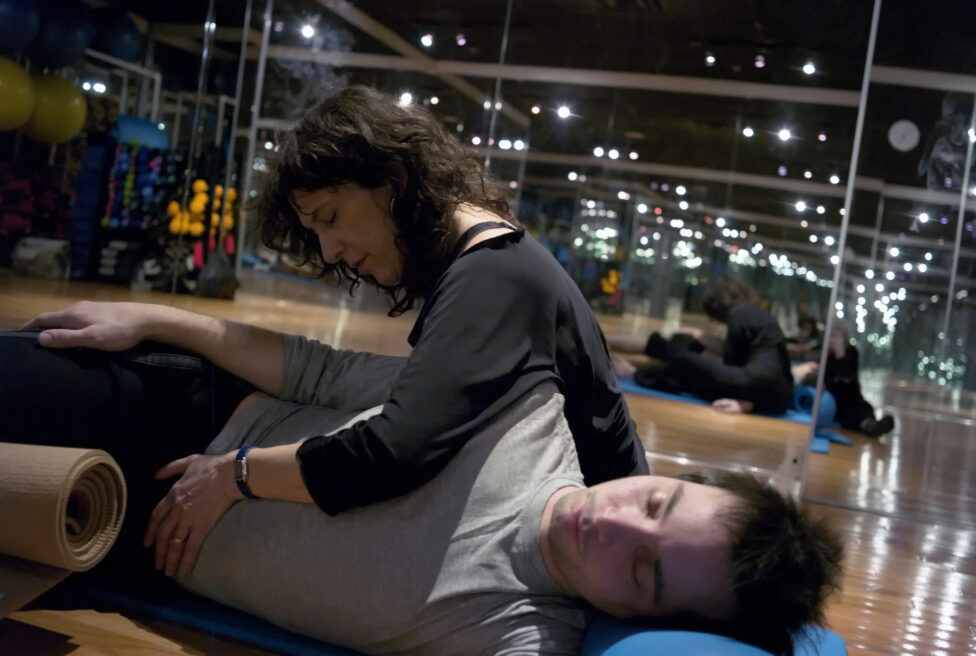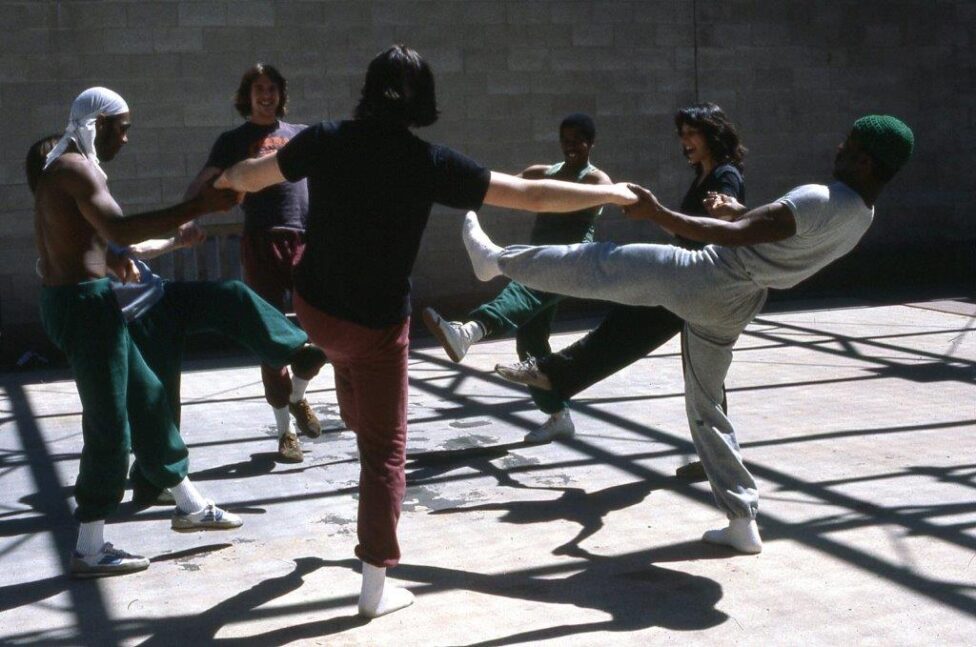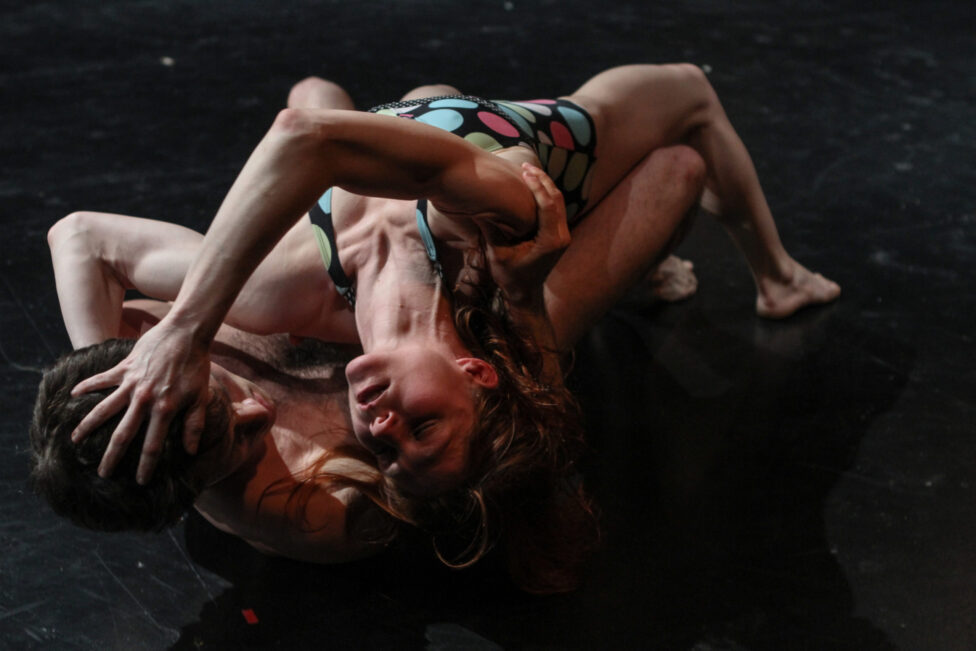Tamar Rogoff, Shawn Shafner and Clare Maxwell in Conversation
Note from Tamar:
I devised Body Scripting 40 years ago as an antidote to the formal dance training that pretty much closed down my body and stifled its joy. Body Scripting brought the lost feeling back and began a dialogue that has nourished me, giving me a choreographic vocabulary and a way to teach that I can call dance – something concretely physical and mysteriously soulful. The layers of infinite things to be understood within the body are constantly unfolding, and I address them piece by piece. Each and every bit of the script gives me an embodied glimpse into the unfathomable whole.
Tamar Rogoff:
Body Scripting simply investigates the body, experientially. There are three different prompts. The first one is: designate a place or a space in the body. This can be any physical landmark, it can be the sternum, it can be the back of the tongue, it can be the space between the nose and the mouth. As I was saying to Clare before, there is infinite choice for the designation.
Once we settle on where we’re designating our focus, then there’s the second step: to concentrate and focus on what we’ve designated as a part of the script. And the third is: the investigation of that place. So, so much happens within this.
I think the best thing we might do now is to give you, Clare and Shawn, a Body Script. I’ll surprise you with the script and we can watch you do it. Is that okay with you?
Shawn Shafner: Sure. Okay.
TR: So because we’re seated, you can do it seated. The first place is my well known and loved place, the sternum.
Clare Maxwell: Can I just say Tamar, for people who are listening or reading, just try it. See what happens if you try it.
TR: Yeah, you might tap on your sternum. You might feel the quality of it. So sternum is the first designation. The second designation is the web between the thumb and the next finger, that sort of soft place. So you have the sternum and then the web between the thumb and the second finger, both. And the third place is, if you think of your sacrum, think of what you might address as its center or midline. It’s so very geographic, archaeological, and architectural. I’m building something. So there’s a sternum, there’s the space between the thumb and the second finger. And then there’s looking for the center of the sacrum. What we’re saying is, you’re instigating movement from your concentration in these places. So you might try to do one and then the second one and then the third one, and you might start playing around with using two of them, or the space between them. So I’m gonna start you off with that. And maybe you could turn on your cameras so that we see from your sit bones to the top of your head. Oh, stand up (often we use music but for now we’ll just watch) Shawn, can you undress?
SS: [Laughs] I thought you’d never ask, Tamar.
TR: Well, if I had my choice, I would have naked students. But you know, these days you can’t. All right, just begin, you’ve got your three designations, you’ve got your script.
So we’re watching. Shawn began with the web, between the fingers and moving through his sternum. He is flowing…Claire’s beginning with her sternum. So what you find is that this sort of stringent request to focus really sends the message to the whole rest of the body to help out. So you don’t ever see someone Body Scripting, leaving out an arm or a foot unconsciously dangling. It’s almost like that intense request brings in all the neighbors. Bonnie Cohen uses this idea of brain to cell and cell to brain. The idea that you might be playfully telling your sternum: what happens if I drop it? If I swerve it, if I revolve it? What happens if I staccato? So you send ideas to your parts that you’re working. But then you quiet down and you begin to listen.
And one thing leads to another and you begin to feel the sternum-ness, the atmosphere surrounding it, it’s like being a traveler going to different countries, seeing, feeling, hearing the language, eating the food. There’s a sense of parts and places in the body. So you can go back and forth between saying, ‘what if I try this?’ and then being in what you’ve tried, sensing, breathing into it. Things can arise, like anything can arise, an image can arise, a situation could arise. For example, we’re just talking about the sternum. If the sternum is dropped, there’s a feeling tone in the body, you might recognize it, it might almost feel like a character. It’s a utilitarian way to put this, but in an everyday way, we don’t ask our bodies to do this. It’s beyond our habitual patterns, and it’s beyond the dance habitual patterns.
Yeah, and there’s that playfulness, that openness to letting things go. So if I said, here’s a fourth one guys, the space between the tip of your nose and your screen, the space between the tip of your nose and the screen.
Okay, so let’s give it one more minute. We could give it four more hours and you would never run out of possibilities, good, you can find…Okay. Okay. [Laughs]
I’ll pass it to you guys. What happened? It’s hard to come back, you know? When I leave class there’s a funny story about walking out in the West Village and a drug dealer saying to me, “loose joints, loose joints”. And, me saying thank you. Because class is like a timeout place where you’re not thinking of your shopping list. You can’t literally absorb all the ‘I’m too fat, I’m too thin, I’m too this too that, I’m not doing that right. She’s doing it better.’ You couldn’t do the Body Script.

Photo by Harvey Wang
[ID: Tamar places her hands across the torso of Gregg Mozgala, who is side-lying in a dance studio.]
CM: Well, I can. [Laughs] But, I remember when I came to class, that you were very sensitive to that. And you could read that. And you could see when I was doing that, and you could see when I wasn’t doing that. But what you didn’t know was what was taking me out of that place. You know, it takes a long time to get to know, really, with this kind of detailed inner workings of a body mind, like, how that person actually ticks. And I remember you saying to me: “I don’t say a whole lot to people for a while.” And that was very helpful to me, because I’m very sensitive to what anybody says.
SS: I think there’s a vulnerability that comes into class with us. Of course, it’s there in the dance class with the strict ballet master beating time on the stick, too. But it’s sort of not in the same way, right? It’s like, it’s beaten out of you. And there is something to that circle we stand in during Body Scripting classes, there is something to the humanity that I think you approach your work with, Tamar. We tell jokes in class. That’s like a standard procedure, you know, and that’s community building. Even in this pandemic time, that’s been a really important component of keeping the group together, you know, that you’ve expressed, and that we’ve seen from the folks in class. They want to see one another, they want to talk to one another. And I think that’s partly because I remember when my current partner came to class, and Tamar came up to me after and she said: “Well, you should stay with this guy, he’s good. I see a lot while people are out on the floor.” Something like that, right? So, I think you create an atmosphere where people can really be themselves. And when we can get out of our own heads, we get into our sternums.
I think there are times for me (even in that improv) where near the end, before we brought in that fourth thing, I was reaching my place of “well, I think I found all I have to find.” And part of the beauty of class is that we keep going. And you’re really asked to notice what it feels like to get a little bored maybe, or to come back. Or Tamar drops a new suggestion in, and your ability to see what’s not been happening in the room, or to see what wants to happen in your own body, or what the possibilities are incorporating that suggestion reminds me, ‘Oh, yeah, staccato.’ Like, that’s not in my body pattern to do myself. And that’s part of the value of class, as well, is that it interrupts our habitual patterns. I often tell people who are coming to class, it’s brain work as much as anything else. And if you come wanting to sweat, you know, you might get that out of it, or some sort of workout. But that’s not really guaranteed. Because every class is different. We really don’t know what will happen. And I also think people love that. Over Zoom—when I thought, well, maybe I’ll offer pre-recorded classes, or record during class and let people watch them after. There’s been the desire from most participants (I think) to not only be there live, but to not know what was going to happen. No one said, “oh, yeah, I want to sign up for a four week clinic on hips.” They were like, “I don’t care, I come to class, that’s fine. Because we’re all going to find out together what’s going on.”
TR: It was interesting, when I taught at NYU, I taught in the Experimental Theater Wing for 10 years. And, I had the students spend a week with different body parts. I said, these parts are now in the bank, you are never going to forget this week. I have a very high standard for my own eureka moments. And I have never taught a class in the 40 years where I haven’t had a eureka moment, because I design the class to newly engage each time.
We stand in a circle a lot when we work in class, but even that can become a habitual pattern, staying in the circle. Last week, I started on the floor. So the idea is to look for your resources. Getting bored? Okay, yeah, staccato. What’s the front body saying to the back? There’s just what I call the “what ifs?” What if I was trying to sing a song while I was doing this, there’s no limit to what ifs? So you can get bored with yourself pretty quickly. But there’s nothing boring about the body. Nothing.

Photo by Maggie Hopp
[ID: Tamar holds hands with a group of five smiling people. They balance on one-leg as they dance on the roof of a maximum security prison in Manhattan.]
TR: I think that’s the gift to people with disabilities who come to class. It’s not medical. We were tortured in our dance worlds, they were tortured in their medical worlds. And so it is a rescue mission, in that sense, to look at what’s powerful about the body, what resources we have, how strong is our concentration, our imagination. I work with children with cerebral palsy in Spain, and they may not be able to walk, but if they’re carrying the crown to the king, they’re gonna walk. And it’s just the power of how the imagination organizes. For me there’s just never an end to the wonder, the awe, and the intricacies of how things work in the body. And I take little bits of information, and I’ll work on them for years. I’ll make them mine. I really want just a few more minutes for the two of you to talk a little bit more. Because I can see how things are received, I mean, I can see with my eyes, but it’s so interesting when you tell me your point of view, and what you love best and what is most challenging. That kind of conversation will change what I do in my next class. So I appreciate it. I just wonder if you have anything more to say?
SS: Well, I’ll just interject, not necessarily on that. But the thought had come to me before, while you were speaking. This class is really a liberatory practice, and we all have different bodies in different ways. I think, as we’ve talked about, we get told we’re not good, or we’re bad in different ways. But class offers a paradigm through which to find freedom within whatever you have. It makes me think of your teaching of Body Scripting work in prisons, Tamar. Or I feel resonance in my own work now with people with cerebral palsy, particularly one student I’ve been with for years now, who may have what someone might consider a limited range of motion of certain parts. But when the music is playing, and his eyes are closed, and he’s just dancing, there’s freedom there. And real beauty, I mean, moments of really profound beauty. I just said to him a week ago, ‘that was the most beautiful dance I’ve seen in months, that you’ve done with your hands.’ The quality of attention that’s been cultivated, whether it’s through the focus on a body part or the imagination, I think it’s all part of the same thing.
I guess for me, in many ways, that has been the content that has changed my life. And as you said, like with those ETW students, I’ve had 18 years of indexing my sternum into the library of my brain, like the neurological framework that maps my sternum onto my body. And incredibly, it is still growing, even though it’s so much greater than it was 18 years ago. So that experiential knowledge, and what little training I’ve had around trauma, makes me think that the class is a real antidote, as you said, because it gives us embodied experiences of the good stuff.
There are infinite choices, we have choices in class over what we do with our bodies. And that is profound, you know. Again, the way the class is held, no one was ever yelled at for being late. I think you’ve sometimes asked me not to be late as someone who’s, you know, really trying to learn this work. But there have been people who come an hour into class, just as a standard. That mindset of you’re not going to be yelled at, there’s never a bad time to show up, you don’t have to feel guilty. That’s I think really critical to support the work itself, to make people feel safe and comfortable, to make me feel safe and comfortable.
To know that if I’m super into something I could explore it and take time with it. This was the first class I ever came to where I saw people not follow instructions. And given support to do that. People who got really excited about something, or interested, and even though you were ready to bring the class back and to move on to something else, you might say, “go, you go ahead and you stay with that.”
Clare, I’ve seen you be one of these people. You’d be one of these people who was like, “I’m just lying down on the floor right now. That’s where I’m at.” And it’s never like, “get up off the floor, what are you doing?” But there’s either a wisdom of thinking, “Oh, I see what’s going on there,” or a curiosity that says,”Well, I don’t know what’s going on there, but I don’t need to do anything about that now. Let’s wait five minutes, and if she still doesn’t get up off the floor, we’ll talk.” And I think that’s part of what’s helped the class to accommodate people with different needs. There is a curiosity and an authentic interest and a non-hierarchy, in the same way that the body doesn’t have a hierarchy. Maybe that judgment about the body is arguable, to some extent, but in Body Scripting place as much value on the web between the thumb and first finger as to the sternum. And so similarly, when someone has a very different experience, that’s valuable to everyone in the room, and I think that comes across. So those are all things that I think are ultimately why I kept coming back, you know, not just because it changed the way I held my body or felt my body or understood it, but it was the freedom to thrive and flail within that, and to feel supported and safe coming back.
Classes take place at LaMama in NYC, Tuesdays and Fridays 10:30am-12pm ET. A Zoom option is also offered. $20; no one turned away. More information at www.TamarRogoff.com/ongoing-cl…





